VULCANISM AND ITS EFFECTS oN LANDSCAPE
Volcanicity involves the processes through which gases and molten rock are intruded within the earth's crust (i.e. trapped beneath the earth's surface within surrounding country rocks) or extruded onto the earth's surface (i.e. the gases and molten rock (lava) are ejected or poured onto the earth's surface).
As was observed with faulting, the process of volcanicity is connected with radioactivity and thermal convection. Molten rock known as magma originates from the upper plastic layer of the earth (mantle). The mantle rocks are dense in nature compared to crustal rocks, but due to the high temperature within the mantle, it exists near melting point temperatures. Additional heat that eventually brings these rocks to melting point is generated by friction along rock surfaces at boundaries of tectonic plates that form the earth crust. The friction is largely the result of faulting and other crustal movements.
HiAn Introduction to
Volcanic activity is nearly always associated with major fault zones though not all fault zones give rise to volcanicity. With increased temperatures, the lighter elements of the dense mantle melt and begin to rise to the surface as magma. The molten rock rises because of the lower pressure at the surface and as it does it forces its way along fissures in the continental rocks created by the explosive activity of its own escaping gases.
When magma erupts at the surface and loses its gases, it is known as lava. It is this escaping gases especially steam which because they expand rapidly due to the lower pressure, cause many eruptions to be explosive. The results of these various processes of volcanicity are responsible for the development of two major types of volcanic land forms, that is, extrusive and intrusive land forms.
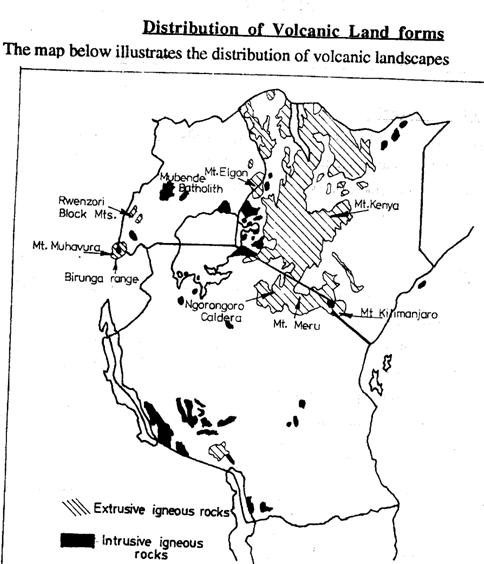
The material erupted builds up around the vent, generally in the form of a cone or a dome with a funnel-like depression called crater at the summit. As long as there is a supply of magma, a volcano will continue to grow to a height to which differences in pressure can force the erupted materials. If pressure becomes insufficient for magma to reach the crater, the molten rock may force its way to the surface through other fissures and build parasitic cones on the slopes of the main volcano. Parasitic cones develop if the chief vent becomes blocked. When magma solidifies along fissures it forms dykes. Over a period of time a volcano may change its mode of eruption and thus its general characteristics. For this reason any classification is bound to be arbitrary.
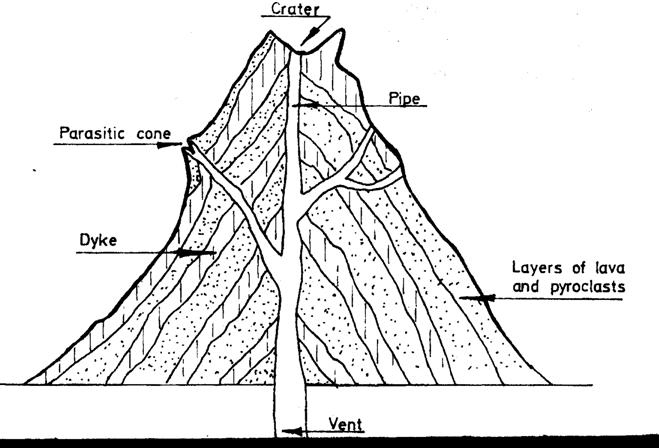
TYPES OF VOLCANOES
(i) Explosion Crater (Ring Crater)
This is a shallow flat floored depression surrounded by a low rim of pycrolasts and local rock. This type is usually 50 metres high and tend to exist in groups. If an eruption consists of only escaping gases, the explosion will punch a hole in the ground. The ash and dust thrown up into the air by the gas will fall back around the hole and will build up a rim around the hole. This type of crater is known as a ring crater as indicated in the diagram below.
Explosion Crater
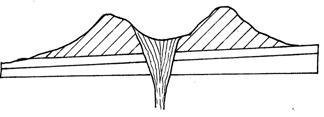
Examples include south of Fort Portal between L. George and Edward, there are more than 200 explosion craters e.g. L. Katwe, other examples include those near L. Basotu in Tanzania.
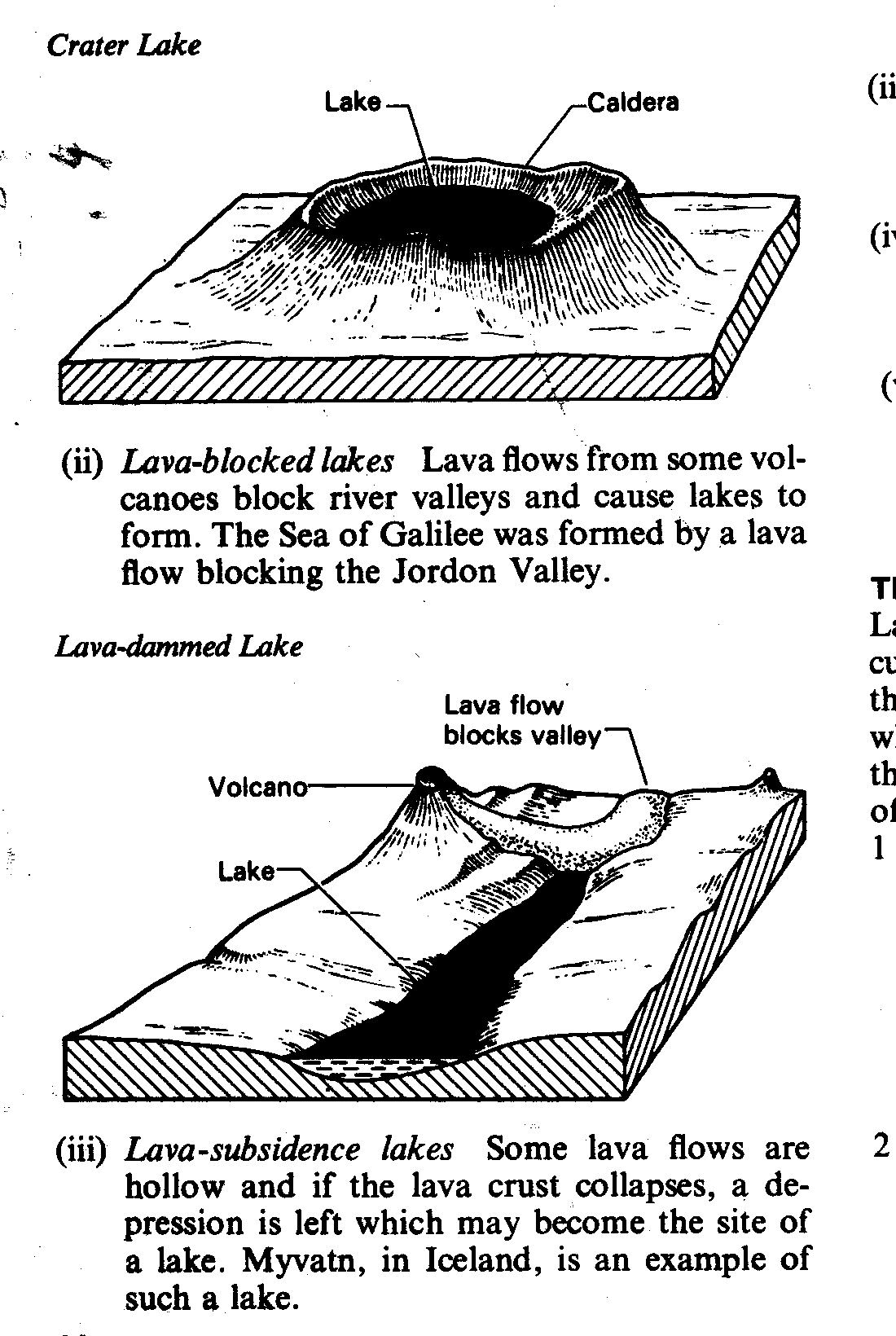
ii) Ash and Cinder Cones (Scoria Cone)
These are small symmetrical cones of pyroclasts usually less than 150 metres with fairly steep sides of between 25° - 35° . Their craters are large and cover all summit area. Cinder cones have steeper slopes man ash cones. Both types often erupt in groups and on flanks of larger volcanoes. The magma has a high content of gas and the eruption is explosive. The diagram below shows ash and cinder cones.
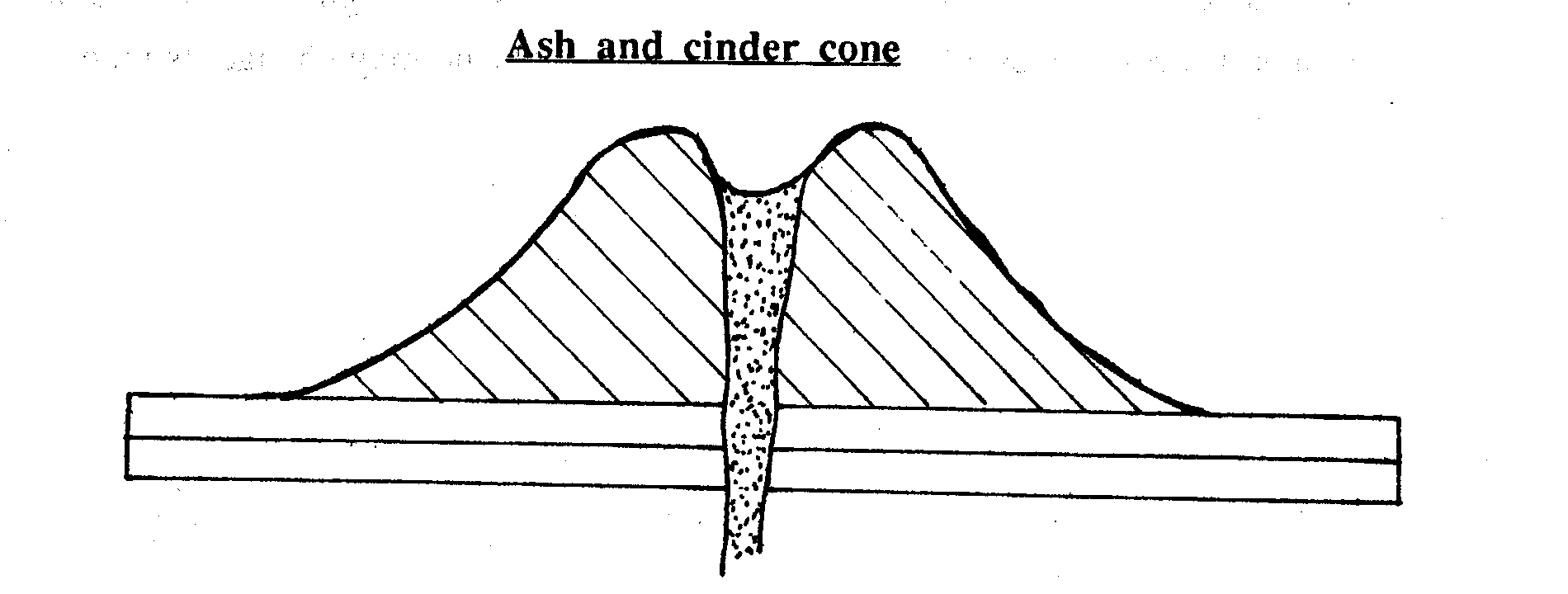
Examples of ash and cinder cones include the B airier volcano south of L. Turkana, Likaiyu is a black cinder cone on the southern slopes of the Barrier. On the northern side of the barrier is Teleki, a large cinder that has been fractured by fissure eruptions of lava. Other examples include the Kitsimbanyi north of Nyamlagira in Zaire. Others are Busoke, Bitale, and those that lie between Muhavura and Lake Mutanda in South Western Uganda.
More examples include Sarabwe and Fileko N.E. of Tukuyu in Tanzania. There are also examples such as Mathioni, Sambu and many others in the Kibwezi area of Kenya.
iii) Basalt Dome (Shield Volcano)
This is a large flat topped convex dome of basic lava with gently sloping sides, usually low in height relative to the large basal diameter. This shape is caused by very fluid lava which is able to flow through numerous fissures rather than a single vent. Small subsidiary cones may form along fissures. Oases are easily released from basic lava, and eruptions are therefore not explosive. The diagram below depicts a basalt dome.

Basalt dome
Examples of basalt domes exist along the Uganda-Zaire border in the Virunga or Mufumbiro Ranges which also include numerous small cones and craters. The crater was formed by the subsidence of the volcano summit. Its floor is not flat but appears as a series of descending levels ending in deep pits or lava sinks which contain molten lava.
iv) Cumulo Dome
This is a steep sided convex dome of acid or intermediate lava. This viscous lava doesn't flow far and therefore piles up around the vent. It hardens quickly and later intrusions because they are unable to reach the surface, may force initial layers outwards. It usually does not have a visible crater. The diagram below shows a cumulo dome.
Cumulo Dome
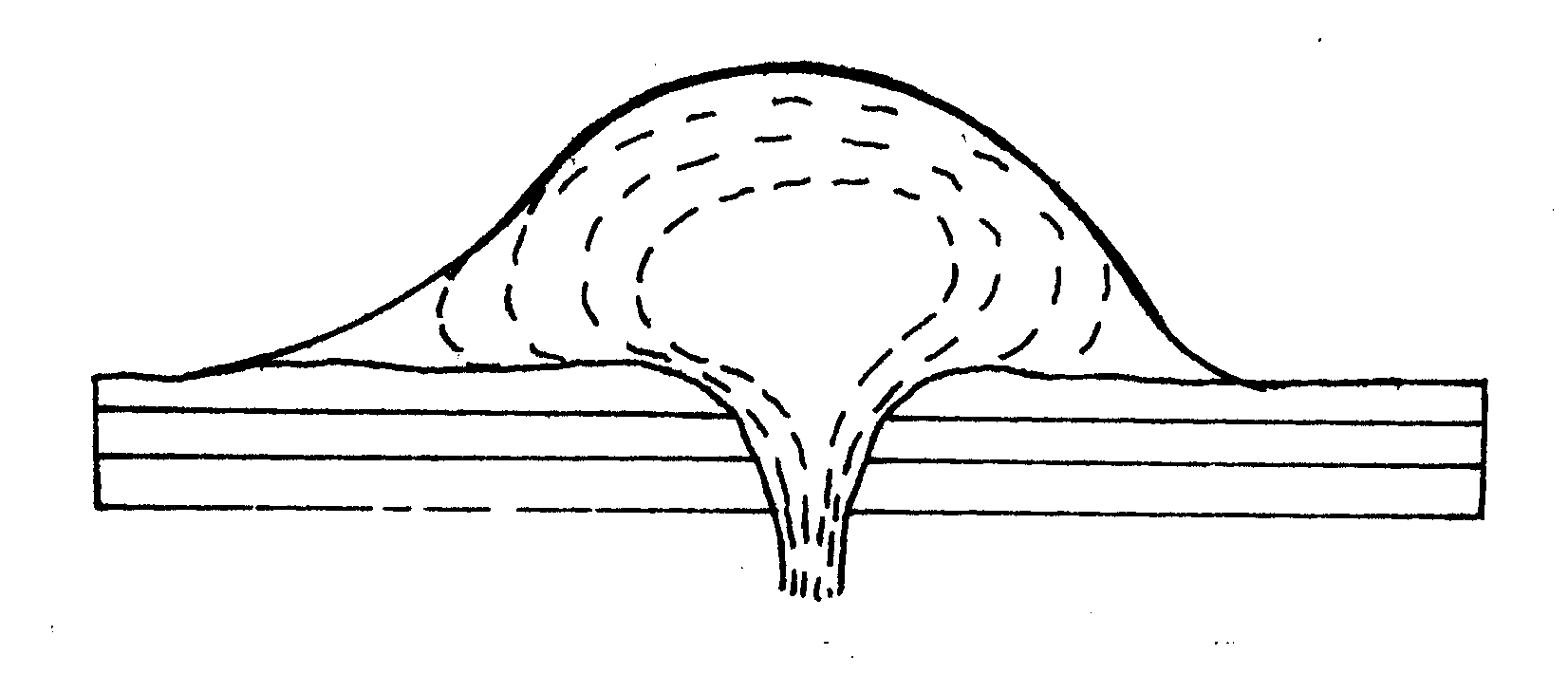
Examples of cumulo domes include: Ntumbi located 30 km east of Mbeya in Tanzania. Cumulo domes may sofnetimes form inside a crater pr caldera of a larger volcano. These types of cumulo domes are Known as tholbids e.g. a tholoid was formed in the caldera of mount Rugwe in Tanzania.
v) Plug Dome
When lava is so viscous, it may be forced out as a rigid cylindrical plug. The base of the plug is surrounded by exploded debris. Eruptions are very explosive and the plugs are extruded together with clouds of hot incandescent ash and cinders. The diagram below shows a plug dome.

Good examples of this feature can be cited from the Hoggar mountains in Algeria e.g. Ilaman, Oul and Iharen. Other examples are in the Mandara-Mountains, northern Cameroon e.g. Roumsiki and on the island of Sao Tome (e.g. Cao Grande).
vi) Composite Volcano (Strato Volcano)
This is a large cone built of alternating layers of pyroclasts and lava with concave sides at about 20° - 30°. They often grow to great sizes and may have more than one crater, Eruptions are explosive or elusive depending on the gas content of the magma. If the top of the cone is destroyed in an eruption, a secondary cone may form. Parasitic cones are common on the sides as shown in the diagram below.

Composite Volcano
Examples of simple composite volcano include Muhavura in SW Uganda in the Virunga Ranges Oldoinyo Lengai in Tanzania and also Mgahinga in Uganda. While volcanoes such as Elgon and Kenya are of the single central vent type.
And examples of complex composite volcanoes include Kilimanjaro in Tanzania, Meru in Tanzania and Nyiragongo in Zaire.
vii)
a)This is a large rounded depression resulting from destruction of the upper part of the volcano in a violent eruption. Sometimes the summit cone is blown off and explodes into incandescent rocks and ashes. Calderas are also formed through subsidence. Major eruptions by reducing the supply of magma leave a huge opening beneath a volcano. The weight of the overlying cone becomes too great and faults develop and it collapses into the opening.
Calderas formed by collapsing
Napak volcano in N. Eastern Uganda was built up on a layer of ash which later proved insufficiently strong to support the mountain so that it collapsed outwards.

Calderas formed through block subsidence
When a volcano is formed, a cavity is left deep underground from where magma or lava originated. The weight of the volcano over this hole causes it to subside in a block back into the ground into the hot cauldron of magma below where the rocks are melted again.

An example of subsidence type of caldera is the Ngorongoro crater in Tanzania.
c) Calderas formed by violent disintegration
The presence of the mass volcanic mountain can act as a plug hindering the release of more magma, in particular gases and steam. If pressure builds up considerably then the volcano above can be violently blown up and shattered into fine dust fragments which are blown into the atmosphere. An example of a caldera formed by violent eruption is the Longonot caldera in Kenya.
The diagram below illustrates a caldera formed by violent eruption.


Dissected Volcano
This is a volcano with its slopes and crater deeply dissected by radial valleys. Erosion develops first on the upper slopes, and in early stages of dissection, triangular facets of the original volcano known as planezes may remain on the lower slopes. /' The diagram below shows a dissected volcano.
An example of a dissected volcano is mount Kenya.
ix) Volcanic Neck
This is a central core of solidified lava in the vent of a volcano exposed by erosion of the surrounding cone. Besides the volcanic neck, differential erosion may also reveal resistant dykes which have solidified in fissures of the original cone.
The diagram below shows a volcanic neck.
 44
44
An example of volcanic neck is the Tororo rock in eastern Uganda and Mawenzi, Kilimanjaro in Tanzania.
2. Lava Plateaus
A lava plateau is an upland with a generally level floor or summit and is made up of successive layers of lava. It is formed by the eruption of very fluid basic lava from a large number of linear or fissure vents in the crust. As successive eruptions take place with little explosive action, very mobile lava spreads over preceding flows. Eventually the depth of the lava may be hundreds of metres thick, completely covering any original landscape of hills and valleys.
In East Africa there have not been extensive lava flows to form plateaus. However, examples of this type of landscape are found along the eastern slopes of the Aberdare Ranges in Kenya i.e. the Laikipian Basalts, Kericho plateau, Yalta plateau, Kapili plains.
3. Hot Springs. Gevsers and Steam Jets or Fumaroles
These category of volcanic landforms are quite common in the rift valley areas of the Kenya Highlands and in western Uganda along the rift valley. The hot springs of Sampaya north east of Fort Portal, and others at Kitagata, arid Kibiro may be taken as examples to show how they were formed.
These hot springs are found along the edge of the western rift valley along faults. These fault lines provide natural lines of weaknesses through which hot gases and water can rise. The gases heat the water which bubbles out as a hot spring. The gases bubbling up through the water make it look as if the water is boiling. The water may get some of its heat from direct contact with hot rock underground.
In the case of a geyser hot water is thrown into the air from a hole in the ground. Every now and then, sometimes at regular intervals, a jet of water shoots out of the ground only to fall back and refill the hole.
As the water in the pipe is heated by the surrounding volcanic rock, some of it turns into steam and may be trapped within the bends of the pipe. The water at the bottom cannot turn into steam because of the pressure of the water above it. This bottom water is heated beyond 100°C until eventually some of it turns to steam and rises. This reduces the pressure of the rest of the water, more of which turns into steam. This shoots up the pipe, taking with it a lot of water. The water then refills the pipe and it takes a little time for the cooled water to become hot enough to repeat the whole process. A good example of a geyser can be found at Lake Bogoria in the Kenya rift valley.
Steam jets also involve water being heated by hot volcanic rocks and turning into steam. In this case possibly because there is less water, all the water turns to steam and the steam shoots out of the ground non stop e.g. near lake Naivasha in the Kenya highlands the steam is being condensed to provide water and attempts are being made to produce energy from the steam. The diagrams illustrate what has been explained above.

Gases that are generally associated with fumaroles or steam jets include carbon dioxide and gases containing sulphur from which bright yellow sulphur crystals are deposited. Examples of fumaroles or steam jets include mountains Kilimanjaro, Longonot and Nyamlagira.
The table below illustrates some types of volcanic land forms in East Africa.
|
TYPE
|
DESCRIPTION
|
EXAMPLE
|
|
Composite Cones
|
Characterised by alternating layers of ash and lava
|
Mt. Longonot, Kenya, Mt. Kilimanjaro, Tanzania
|
|
Calderas
|
A grear hollow (more than 2 kilometres across) in the top of a volcano, caused either by massive explosions blasting away the top of the volcano or by the inward collapse of the steep sides of the volcano after a great eruption.
|
Ngorongoro, Tanzania Mt. Longonot, Kenya, Napak in Uganda |
|
Cinder or ash cones
|
Composed almost entirely of small loose fragments of solid lava
|
Likaiyu, south of Lake Turkana |
|
Explosion craters
|
Circular hollows (up to about 500 metres across) caused by violent explosions of gas through the crust |
Lake Katwe and 200 more (many with lakes) in southwest Uganda) |
|
Parasitic or subsidiary cones (or ash or lava)
|
Cones which develop on the sides of original volcanoes, sometimes these may be referred to as side vents |
Mt. Kenya, Mt. Muhavura, Uganda |
|
Lava plateaus
|
An outflow of very liquid lava (often basalt) along a fault to form a plateau or plain
|
In Kenya; eastern slope of Aberdare range, Lakipia Plateau, Kericho Plateau, Yatta Plateau, Yapiti Plains.
|
Intrusive Volcanic Features
Sometimes rising magma may not reach the earth's surface but rather remains imbedded within the surrounding country rock beneath the surface of the earth as intrusive features of volcanicity. The major types of intrusions include:
i) Batholith
This is a very large intrusion of generally granitic rock which is formed at great depths. When exposed batholiths may form uplands covering hundreds of square kilometres. Some are magmatic in nature in that they result from largescale intrusion of molten rock. This type is of uniform rock and has clear cut margins.
Others are due to metasomatism, that is, the replacement of the original rock by mineral and chemical changes. This type has no sharp boundaries but grades progressively into metamorphic rocks, hence, they have been called metamorphic granites and appeal' to originate deeper than the magmatic type.
In the diagram below, a batholith is shown with other intrusive volcanic features.

Examples of batholiths in East Africa include: Tanganyika batholith outcropping overmuch of the country between Mwanza and Iringa. Singo batholith in Uganda and small batholith outcropping between Kikandwa and Kawungera 70 km North West of Kampala.
(ii) Dykes
This is a vertical or steeply inclined rock sheet intruded into fissures. Its thickness varies from centimetres to hundreds of metres. They may occur in large swarms and have parallel or radial pattern. Differential erosion produces a wall-like ridge or trench depending on whether the dyke is more or less resistant than the nearby rocks.
In East Africa examples of dykes include those around the volcanic plugs of eastern Uganda e.g. Sukulu hills. In Kenya a dyke can be found West of L. Turkana where they form linear trenches in sedimentary grits.
(iii) Sill
This is a tabular rock sheet intruded horizontally into fissures. Their thickness varies from centimetres to hundreds of metres. They are intruded within rock strata. They may occur singly or in large groups. After denudation resistant sills may form escarpments or flat topped hills. In rivers they may cause water-falls.
Sills are found in South Africa i.e., the three sisters in Cape Province and Spandau .
iv) Laccolith
This is a dome shaped intrusion with a flat floor. It is formed from viscous magma which is unable to spread far and accumulates in a large mass, arching up the overlying rock. If the laccolith is more resistant than the adjacent rocks, after denudation it may form an upland. Good examples of this landscape are found near Voi in Kenya. They are exposed by erosion and weathering.
v) Lapolith
This is a very large saucer shaped intrusion. The shape may be due to increased weight causing sinking. After denudation the upturned edges sometimes form outfacing scarps. Examples of this landscgpe are found in Southern Zimbabwe near Belingwe.
vi) Ring
These are annular (circular) intrusions of one or more ring dykes formed by the process of Cauldron subsidence. A circular block of crust subsides into an underlying magma vault causing magma to rise along vertical fractures around the block forming ring dyes. Examples of ring complexes are found in Malawi in the Chamber Plateau.
Active. Dormant and Extinct Volcanoes
Extinct volcanoes refer to those volcanoes that show no sign of further eruption and much of the original structure may have been destroyed by denudation.
Dormant volcanoes are those that have been known to erupt and is not yet thought to be extinct. Some volcanoes show only limited activity in forms of fumaroles. Fumaroles are small subsidiary vents from which gases escape e.g. Mt. Kilimanjaro.
Broadly speaking, when a volcano is described as active it means that it has erupted or is thought to have erupted during the last 500 years.
In East Africa volcanoes that are considered active include:
Western Rift i) Nyamlagira ii) Nyiragongo
Eastern Rift
i) Teleki
ii) Likaiyu
iii) Longonot
iv) Meru
v) Oldoinyo Lengai
It should be borne in mind that the world's major regions of volcanic activity are along or near the boundaries of tectonic plates especially those landmasses near the ocean trenches surrounding the Pacific Ocean and in the Mediterranean basin which separates the African and Eurasian Plates. These are also zones of severe earthquakes.
In Africa the distribution of volcanoes is closely related to the pattern of major faults. The most active region coincides with the rift valley of East Africa but there are other areas such as the offshore islands of Reunion, Comoro and the Canaries.
Economic Importance of Volcanicity to man
Minerals are commonly formed during volcanic activities. In Uganda it has been responsible for the creation of volcanic limestones at Tororo (carbonatites) used for cement production.
Diamonds have crystallised out from magma e.g. the Mwadui diamond pipes at Shyinyanga in northwest Tanzania is the largest diamond pipe in the world. It covers an area of 1.46 km2.
Volcanicity has brought about high relief feature e.g. Mts Elgon, Kilimanjaro and Kenya. These landforms are potential tourist attractions.
When volcanic parent Rocks are weathered they develop into very fertile soils that are good for agriculture e.g. along the slopes of Mts Elgon, Kilimanjaro and Mem.
Geothermal energy can be harnessed from the underground heat that is released during volcanicity e.g. at Olkaria geothermal station in Kenya near Naivasha.
Volcanicily is responsible for creating high mountains which induce relief rainfall in areas where they are found, thus supporting agriculture.
Volcanic eruptions can be destructive to life and property especially where human activities are heavily concentrated.
Volcanic landforms create problems of constructing communication network especially where high mountains are formed.
- Landslides are common in areas where volcanic ash constitutes much of the rocks e.g. the heavy rains in Tukuyu area of Tanzania caused several landslides. Around Mts Meru and Rungwe in Tanzania lahars (special type of mudflows composed of saturated volcanic ash) are a common phenomenon. In south western Uganda, lahar deposits of mud, sand and volcanic boulders exist north and east of Sabinio.
Volcanic hills and mountains are areas of serious soil erosion e.g. along slopes of mount Elgon where serious deforestation has taken place.
Granitic rocks which are formed through volcanicity provide gravels for road construction, i.e. tarmacing.

xi) Water supplies
Whereas lava layers can act as traps for water in the sub-soil and so provide useful sources of domestic water. However in some areas the ash and lava layers are permeable and the water drains easily through so that water becomes very difficult to obtain e.g. Mzima spring area in Kenya southeast end of Chyulu Hills in Tsavo national park. In Kisoro Uganda there is limited water supply due to porosity of the soils.

xii) Generally the holes in between boulders encourage pests and vermins to hide easily. This makes these vermins such as rodents to destroy crops e.g in Kisoro Uganda.
xiii) Some sides of volcanic mountains experience rain show effect e.g. the north western slopes of Mt. Kilimanjaro.
xiv) Poor soils due to young volcanic rocks which haven't undergone sufficient weathering e.g. around Rukungiri.
xv) The slopes of volcanic mountains are ideal for extensive forest stands. These can be exploited in several ways.